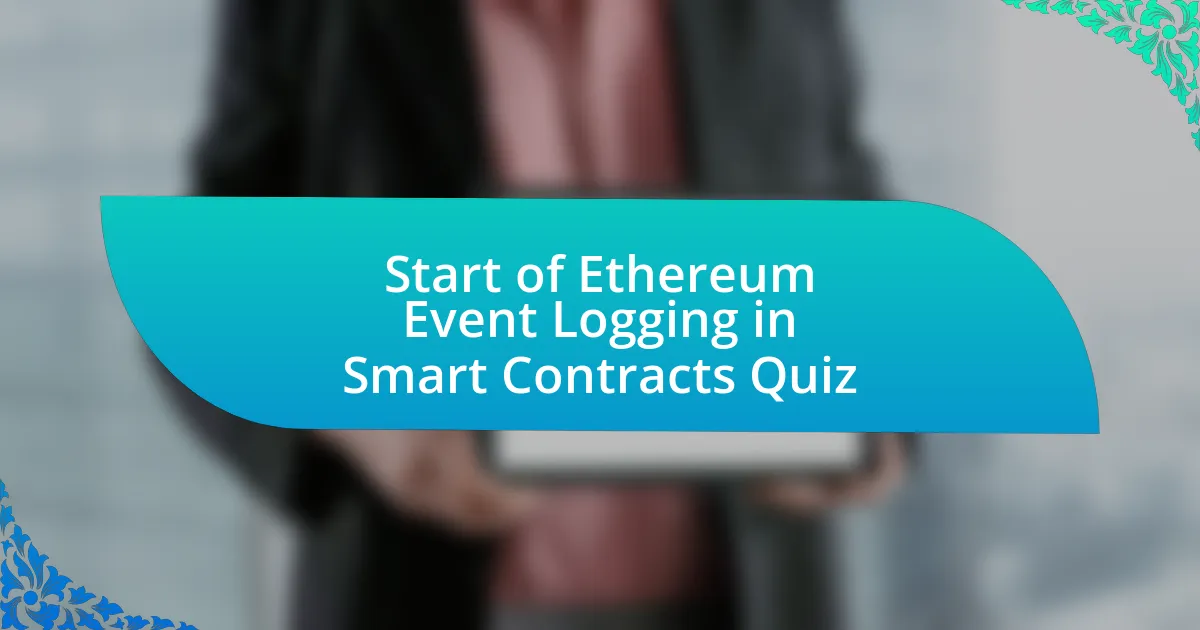
Start of Ethereum Event Logging in Smart Contracts Quiz
1. What are Ethereum event logs?
- Ethereum event logs are temporary data stored in memory while the contract executes and are discarded after execution.
- Ethereum event logs are private records not accessible on the blockchain and are only for internal contract use.
- Ethereum event logs are simple data types that only hold numerical values and cannot store complex information.
- Ethereum event logs are records generated by smart contracts when they execute, providing insight into the events that occurred. They are stored in transaction receipts and can be queried on the blockchain network.
2. What do Ethereum smart contracts emit when they execute?
- Errors
- Transactions
- Blocks
- Events
3. What are the two main components of an Ethereum log?
- Keys and values
- Topics and data
- States and transitions
- Inputs and outputs
4. What is the size limit for log topics in Ethereum?
- 32 bytes
- 64 bytes
- 16 bytes
- 128 bytes
5. What is the purpose of log topics in Ethereum?
- Log topics describe the inner workings of an event and allow for easier searching and indexing of events.
- Log topics manage the execution flow of smart contracts and transactions.
- Log topics ensure the security of smart contracts by encrypting data.
- Log topics store permanent data records for smart contracts without fees.
6. What is the purpose of log data in Ethereum?
- Log data stores more complex and extensive data types.
- Log data tracks the execution time of contracts.
- Log data is used to store user account balances.
- Log data saves account passwords securely.
7. How many opcodes are available for emitting Ethereum event logs?
- 2
- 3
- 7
- 5
8. What is the difference between LOG1 and LOG4 opcodes?
- LOG1 includes four topics while LOG4 includes one topic.
- LOG1 and LOG4 both include two topics.
- LOG1 includes no topics while LOG4 includes three topics.
- LOG1 includes one topic while LOG4 includes four topics.
9. What is the maximum number of topics that can be included in a log record?
- Three
- Five
- Two
- Four
10. How do developers declare an event in Solidity?
- Developers create an event in Solidity with the `function` keyword and its signature.
- Developers define an event in Solidity using the `const` keyword and event attributes.
- Developers declare an event in Solidity using the `event` keyword followed by the event name and parameters, such as `event ownerChanged(address indexed _from, address indexed _to);`
- Developers list an event in Solidity by starting with the `log` keyword and its descriptors.
11. How do developers emit an event in Solidity?
- call ownerChanged(owner, _newOwner);
- log ownerChanged(owner, _newOwner);
- emit ownerChanged(owner, _newOwner);
- fire ownerChanged(owner, _newOwner);
12. What are indexed and non-indexed parameters in Solidity events?
- Non-indexed parameters enhance security, while indexed parameters do not.
- Non-indexed parameters store complex data, while indexed parameters store simple data.
- Indexed parameters are always small, while non-indexed parameters can be large.
- Indexed parameters allow for efficient searching, while non-indexed parameters do not.
13. What is the purpose of emitting events for critical functions in smart contracts?
- Emitting events is primarily used to store all contract data on the blockchain.
- Emitting events helps to increase the gas costs associated with smart contract executions.
- Emitting events replaces the need for storing any data within the contract itself.
- Emitting events for critical functions helps track changes in contract storage and alerts users about updates.
14. How do events provide a mechanism for logging critical actions and state changes in smart contracts?
- Events provide a mechanism for encrypting sensitive data in smart contracts.
- Events log actions by storing them in dedicated database systems.
- Events log actions by creating manual records in external files.
- Events provide a mechanism for logging critical actions by recording them in transaction receipts.
15. What is the role of events in off-chain notification?
- Events can be used by off-chain applications to listen to and monitor specific on-chain actions of smart contracts, triggering downstream logic.
- Events are solely for debugging and do not interact with off-chain systems in any way.
- Events facilitate communication between smart contracts by storing data in a centralized database.
- Events provide a way to permanently store all contract data on the blockchain in a compressed format.
16. How do events support data indexing, processing, and analytics?
- Events only allow developers to emit messages without any support for data insights.
- Events do not support data processing, as they are only for notification purposes.
- Events are primarily used for simple logging without any analytic capabilities.
- Events can be indexed, stored, processed, aggregated, and analyzed to empower developers and analysts to gain data points, insights, and patterns of smart contract activity.
17. How do smart contracts use events for cross-contract communication?
- Smart contracts rely on user-triggered functions to relay messages between contracts.
- Smart contracts use events as a lightweight mechanism to communicate with each other by emitting and listening to specific events.
- Smart contracts automatically sync data with centralized databases for communication.
- Smart contracts delegate their tasks to external oracles to share information.
18. What is the significance of events in security and monitoring?
- Events are only used for storing transaction amounts and not for security logs.
- Events function solely to reduce gas costs during contract executions without any monitoring implications.
- Events in smart contracts serve no purpose in tracking actions and are rarely monitored.
- Events provide a detailed record of actions taken by smart contracts, which can be monitored in real-time for emergency and security purposes.
19. Why are events useful for querying specific activity in real-time?
- Events provide a mechanism for executing smart contract code on demand.
- Events can be easily searched and indexed for quick data retrieval.
- Events are primarily for visually representing data on user interfaces.
- Events are used to permanently store all transaction data on-chain.
20. How do events enable smart contracts to share details of activity taking place on-chain?
- Events store user credentials in the blockchain.
- Events provide a backup for smart contract code.
- Events limit transaction fees on the network.
- Events enable smart contracts to share transaction data via receipts.
21. What are the limitations of event parameters in Ethereum?
- Event parameters can include unlimited topics and any size of data.
- Event parameters in Ethereum are limited to four named parameters and can be 32 bytes in size.
- Event parameters are limited to two unnamed parameters only.
- Event parameters can have a maximum of six topics and can be 64 bytes in size.
22. How do developers use Chainlens Block Explorer’s API backend to create listeners for certain activities taking place on-chain?
- Developers create listeners by querying specific events and parameters.
- Developers create listeners by executing smart contracts manually for updates.
- Developers create listeners by polling the blockchain every second for changes.
- Developers create listeners by sending transactions to the blockchain directly.
23. What is the cost-effectiveness of using events compared to storing data in dedicated storage used by smart contracts?
- Using events offers the same cost as dedicated storage.
- Using events is more expensive than dedicated storage.
- Using events is cheaper than dedicated storage.
- Using events is only slightly cheaper than dedicated storage.
24. How do events support asynchronous triggers with data?
- Events support asynchronous triggers with data by allowing developers to emit and listen to specific events.
- Events do not support asynchronous triggers, relying solely on immediate transaction execution for data.
- Events complicate asynchronous triggers by necessitating direct contract calls for data retrieval.
- Events hinder asynchronous triggers as they require synchronous execution of data.
25. What are some best practices for designing Solidity events?
- Emitting events only for non-critical functions.
- Using zero-indexed parameters for maximum efficiency.
- Emitting events for critical functions and indexing parameters.
- Avoiding the use of events when state changes occur.
26. How do events facilitate cheaper storage in smart contracts?
- Events store data permanently on the blockchain.
- Events facilitate cheaper storage by using transaction receipts.
- Events remove the need for opcodes in smart contracts.
- Events require dedicated storage for data.
27. What is the role of events in smart contract return values?
- Events serve no purpose in returning values from smart contracts; they are purely for logging actions.
- Events can be used to return values from smart contracts by emitting information about the result of transactions, which can be queried later.
- Events only relate to transaction fees and do not convey information about contract results.
- Events are solely designed for storage and do not provide any return values from smart contracts.
28. How do developers use Moralis to query Ethereum event logs?
- Developers make a single API call to the `getContractLogs` endpoint.
- Developers must manually parse blocks for historical log data.
- Developers use a local node to execute full Ethereum state snapshots.
- Developers send a transaction to store logs directly on the network.
29. What is the significance of using Moralis Academy for learning Web3 development skills?
- Moralis Academy teaches traditional web development only.
- Moralis Academy focuses solely on blockchain gaming education.
- Moralis Academy offers courses exclusively for experienced developers.
- Moralis Academy provides industry-leading development courses for all developers.
30. How do events support data indexing, processing, and analytics in smart contracts?
- Events store all smart contract data directly in the blockchain, eliminating the need for indexing.
- Events impede the efficiency of data indexing and only serve as temporary notifications for contract actions.
- Events support data indexing, processing, and analytics by being indexed into data stores and data lakes, which power analytics both internally and externally.
- Events complicate data management and hinder processing and analytics due to their unstructured format.

Congratulations! You’ve Successfully Completed the Quiz!
Thank you for participating in our quiz on Ethereum Event Logging in Smart Contracts! We hope you found the experience both enjoyable and enlightening. This topic is crucial for understanding how smart contracts communicate important changes and events within the Ethereum network. You’ve likely gained insights into how events work, their significance, and how they can enhance transparency and traceability in blockchain applications.
Throughout the quiz, you might have learned about the different types of events, how to emit them in Solidity, and the role they play in the interaction between contracts and user interfaces. Understanding these concepts is vital for anyone looking to build or interact with decentralized applications. This knowledge empowers you to create more robust and user-friendly smart contracts that effectively utilize event logging.
If you’re eager to deepen your understanding, we invite you to check out the next section on this page. It provides comprehensive information on Ethereum Event Logging in Smart Contracts. Explore practical examples, best practices, and advanced techniques that will increase your proficiency in this essential area. There’s always more to discover in the world of Ethereum, so keep learning!

Ethereum Event Logging in Smart Contracts
Understanding Event Logging in Ethereum Smart Contracts
Event logging in Ethereum smart contracts refers to the process of recording events that occur during the execution of smart contracts. This allows developers to listen for specific actions, contributing to a more transparent and interactive application. Events are emitted using the `emit` keyword and can carry parameters, making it easier to track state changes. By logging events, developers gain access to crucial data without needing to query the entire blockchain, thus enhancing efficiency and usability.
The Purpose of Event Logs in Ethereum
The primary purpose of event logs is to provide a way to communicate important information from a smart contract to external applications, like user interfaces or off-chain services. They help in monitoring contract behavior, tracking transactions, and responding to particular activities. Event logs are indexed on the blockchain, allowing quick access and filtering, making them essential for dApp functionality and user engagement.
Structure of an Event in Solidity
In Solidity, an event is defined using the `event` keyword followed by the event name and parameters. Parameters can be indexed, which allows for efficient searching. An event declaration might look like `event Transfer(address indexed from, address indexed to, uint amount);`. When emitted, the data is logged in the blockchain and can be retrieved via web3 libraries, facilitating seamless interactions with users and other systems.
Indexing and Its Impact on Event Logs
Indexing is a crucial aspect of Ethereum event logging. When parameters are marked as indexed, they become easier to filter and search for in logs. Each event can have up to three indexed parameters. This indexing significantly reduces the complexity of retrieving specific events from the blockchain, which is vital for applications requiring real-time updates or historical data analysis within their UIs or back-end processes.
Event Emission and Its Role in Smart Contract Interactions
Emitting an event in a smart contract signifies that a significant change has occurred, acting as a notification to external listeners. When the `emit` keyword is used, it triggers the log entry, allowing decentralized applications to respond quickly to the relevant change. This mechanism plays a pivotal role in the interaction between users and smart contracts, supporting functionalities such as transaction confirmations, state updates, and notifying other systems to react to specific conditions.
What is Ethereum Event Logging in Smart Contracts?
Ethereum Event Logging in Smart Contracts refers to the mechanism that allows smart contracts to log specific events during their execution on the Ethereum blockchain. This feature enables dApps (decentralized applications) to listen for events and react accordingly. Events are emitted using the emit keyword, and they provide an efficient way to retrieve transactional data. The logged events become part of the Ethereum blockchain’s transaction receipts, providing a transparent record for off-chain applications.
How does Ethereum Event Logging work?
Ethereum Event Logging works by allowing smart contracts to emit events during execution. Developers define events in the smart contract’s code using the event keyword, specifying the data that will be logged. When the contract executes a function that includes an event, it uses the emit command to trigger the event. These events can be indexed for easy filtering, making it efficient to find specific logs. The events are stored on-chain and can be accessed post-transaction through the blockchain’s logs.
Where can Ethereum Event Logs be accessed?
Ethereum Event Logs can be accessed through Ethereum nodes and various interfaces. They are available on platforms like Etherscan, which provides a user-friendly way to search for event logs by transaction hash or smart contract address. Developers can also access these logs programmatically using libraries like Web3.js or Ether.js, which interact with Ethereum nodes to query the logs associated with specific smart contract events.
When should Ethereum Event Logging be used?
Ethereum Event Logging should be used whenever a smart contract needs to communicate significant state changes or important actions to the outside world. This includes user activities such as transfers, state updates, or any significant event requiring notification. Logging events can help in dApp development by allowing the front end to react to blockchain changes in real-time without needing to continuously poll the blockchain for updates.
Who typically utilizes Ethereum Event Logging?
Ethereum Event Logging is typically utilized by smart contract developers, dApp developers, and users interacting with these applications. Developers use logging to enable efficient communication between smart contracts and decentralized user interfaces. dApp developers rely on event logs to build responsive applications that react to blockchain events. Users benefit indirectly as they receive notifications or updates based on these events, improving user experience in decentralized applications.

